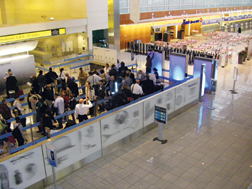
TSA TSA is testing full-body imaging screeners and customer-oriented queues in Baltimore.
|
... backbones, says Randall Walker, the county’s aviation director.
Since 2005, McCarran’s airline tenants also use Radio Frequency Identification (RFID) tags that track and route 70,000 bags checked daily to the correct destinations. With a 99.7% accuracy rate, the chip emits a signal that can be read even if the tag is smudged.
McCarran also has 100 common-use self-service kiosks for 15 airlines. Offsite bag check-in kiosks are at hotel-casinos, the Las Vegas Convention Center and the rental-car center. Southwest Airlines was the first to try the pilot program in May 2006. A third-party contractor picks up and delivers the bags to the airport. McCarran’s eventual goal is to have 10% of bags checked in offsite.
Common-use and off-airport technologies have not caught on as quickly in other airports, but they are working on it. “We’ve started to implement the idea of parking-garage check-in kiosks” at Seattle-Tacoma International Airport, says Dave Tomber, facilities development manager. “We have 10 common-use kiosks and will expand to 85 to 100.”
The ultimate goal is to create “inspansion” instead of expansion of the airport, Tomber says. “By increasing turns at its 100 gates from four to seven a day, the airport reduces near-term expansion needs from 185 gates to 125 gates. “It’s the wave of the future,” he says. “Very few airports have the luxury of overbuilding.”
Arnie Rosenberg, aviation practice leader with Parsons Brinckerhoff, New York City, notes trends like these mean contractors will have far fewer greenfield airport projects to bid for. The opportunities will be in “the move to improve the footprints of existing facilities and improve their sustainability.”
Evolving Project Tools
 |
| LAURIE |
These opportunities also require embracing newer forms of project-delivery tools. The relaunched process for Atlanta’s new terminal included turning to CM-at-risk, which many engineers say can help minimize change orders. “Motivation is moved from a completely financial-based one to building a collaborative environment,” says Ginger Evans, senior vice president with Parsons Transportation Group, Washington, D.C.
Atlanta also used a standardized project tool to save $102 million on its new $1.3-billion runway. The platform required all subcontractors to regularly submit information, progress reports and other items before getting paid.
The point was “to enable the entire project team to participate, not just having a project manager or project controls group be accountable,” says Richard Sappe, industry market manager with Primavera, Bala Cynwyd, Pa., which provided the platform and wrote a case study on best practices as a result. “We need to change how we deliver projects,” he says. “As an airport you have to interact and work with numbers of collaborators.”
That was the theme of a Passenger Terminal World presentation by Robert White, director of management services with Houston Airport System Development Corp. Although the U.S. airport industry may be moving closer toward public-private partnerships, as at Midway Airport in Chicago, he cautions that ,“quite often, in privatized projects...the engineering/procurement/construction entity will get going without [operators’] involvement. Some projects are also done by developers who hire a design consultant but have no real connection with the operator during the process.”
Cutting down on planning time in a fast-track project by foregoing the input of airport users does not fly, White says. “In a fast-track project, the planning process is even more important. Deficient design features equal operational problems,” he says.
Arup associate principal Ralph Orr concurs. “You need an integrated team for the commissioning,” he says. “It’s important also to have operational input in the early stages of planning. It’s not always easy to do. Users are often caught up in day-to-day problems.”
Greening Airports

Santa Barbara Airport Santa Barbara’s new airport terminal project includes a carbon footprint checklist to maximize “green” elements.
|
Can an airport have a carbon-negative footprint? Bill DeCota, aviation director for the Port Authority of New York and New Jersey, thinks it can happen at Stewart International Airport, Newburgh/New Windsor, N.Y. The agency, just months into a 93-year lease, so far has “$500 million and a dream” for the next decade of planning at the 2,000-acre site, he says.
Umbrella-style roofs, electric ground- support equipment, lighting, recycled paving, photovoltaic cells, wind power, LEED Platinum certification—“You name it, this will be an airport where we will accommodate everything,” he says.
Everything will probably have been tested at other airports by then, providing a wealth of benchmarks and examples: solar panels in San Francisco, green roofs in Chicago, solar and photovoltaic panels in Oakland and award-winning recycling programs in Baltimore. “Sustainability is an enormous rolling stone ...

Post a comment to this article
Report Abusive Comment